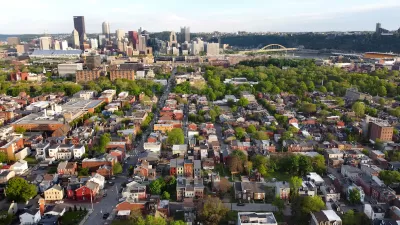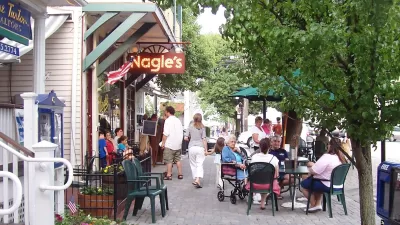The conference bags handed out to the attendees of the 2007 National Planning conference in Philadelphia had four words printed on one side: value, choice, engagement, community. The words echo the long mission statement of the American Planning Association, evidence of what I described last year as the pragmatic position of the profession that refrains from making a larger argument about the form of the city. Here's a taste: "Our collaborative efforts will continue to result in great success for APA and the vital communities we strive to support, and APA members will continue to help create communities of lasting value. We value choice and community engagement, diversity, inclusion and social equity."Since then, a new program from the organization and other evidence may suggest a subtle shift in professional values now underway.
The conference bags handed out to the attendees of the 2007 National Planning conference in Philadelphia had four words printed on one side: value, choice, engagement, community. The words echo the long mission statement of the American Planning Association, evidence of what I described last year as the pragmatic position of the profession that refrains from making a larger argument about the form of the city. Here's a taste:
"Our collaborative efforts will continue to result in great success for APA and the vital communities we strive to support, and APA members will continue to help create communities of lasting value. We value choice and community engagement, diversity, inclusion and social equity."
Since then, a new program from the organization and other evidence may suggest a subtle shift in professional values now underway.
The "Great Places in America" program is an awards program for "great" streets, neighborhoods, and public spaces in America with the goal to celebrate "places of exemplary character, quality, and planning" and "represent the gold standard in terms of having a true sense of place, cultural and historical interest, community involvement, and a vision for tomorrow."
For a profession long maligned for a lack of clear identify or vision, the group of winners from 2007 and 2008 form a remarkably coherent group. Including such iconic places as Philadelphia's Society Hill and Washington, D.C.'s union station, but also more obscure sites like Cleveland's West Side Market and downtown Sheridan, Wyoming. In general the winning neighborhoods, streets, and public spaces are resoundingly urban and historic. None of the winners are strip malls, 1970s planned unit developments, or conventional suburban residential neighborhoods.
The program has sparked remarkably little controversy (that I'm aware of). The local media in winning cities have dutifully covered the story, providing a rare opportunity for a positive story. Few inside the profession or the general public, have raised doubts that the winners were "great" places.
From a larger perspective, the implied argument from the winners is something akin to the argument put forth in Mark Hinshaw's True Urbanism: a vigorous argument for high density, mixed-use urbanism of the type celebrated by Jane Jacobs. I'll leave it to someone else to closely evaluate the criteria and winners in a more systematic way, but the program makes it clear these are places the APA believes people want to "live and work everyday." Meanwhile, outside the world of the professional association, a shift has taken place.
Although they carry a small percentage of total travelers, diverse cities across the country are making major new investments in public transit systems. The president talks straight-faced about developing high speed rail. Even the lowly inter-city bus may have stabilized and begun a cautious comeback. Present shocks aside, the housing market is displaying unexpected patterns with an "inward momentum" revitalizing center cities. Green building and mixed-use development are becoming the norm. Sophisticated planning efforts, including complete streets programs, historic preservation, and innovative forms of zoning are flourishing in most cities. To be sure, these trends have many causes: energy costs, changing demographics, even global warming. However the factor of changing culture or values cannot be eliminated.
In an article last year I described why I thought New Urbanism has been such a misunderstood and controversial movement. One of the responses on a private listserv criticized the article for not offering any solutions or alternatives, something I found troubling. However, I think the solution has been right here under our noses all along. Many of the values of New Urbanism are becoming the profession's mainstream values.
We are entering a new era of normative urban planning in America.

Planetizen Federal Action Tracker
A weekly monitor of how Trump’s orders and actions are impacting planners and planning in America.

Map: Where Senate Republicans Want to Sell Your Public Lands
For public land advocates, the Senate Republicans’ proposal to sell millions of acres of public land in the West is “the biggest fight of their careers.”

Restaurant Patios Were a Pandemic Win — Why Were They so Hard to Keep?
Social distancing requirements and changes in travel patterns prompted cities to pilot new uses for street and sidewalk space. Then it got complicated.

Platform Pilsner: Vancouver Transit Agency Releases... a Beer?
TransLink will receive a portion of every sale of the four-pack.

Toronto Weighs Cheaper Transit, Parking Hikes for Major Events
Special event rates would take effect during large festivals, sports games and concerts to ‘discourage driving, manage congestion and free up space for transit.”

Berlin to Consider Car-Free Zone Larger Than Manhattan
The area bound by the 22-mile Ringbahn would still allow 12 uses of a private automobile per year per person, and several other exemptions.
Urban Design for Planners 1: Software Tools
This six-course series explores essential urban design concepts using open source software and equips planners with the tools they need to participate fully in the urban design process.
Planning for Universal Design
Learn the tools for implementing Universal Design in planning regulations.
Heyer Gruel & Associates PA
JM Goldson LLC
Custer County Colorado
City of Camden Redevelopment Agency
City of Astoria
Transportation Research & Education Center (TREC) at Portland State University
Camden Redevelopment Agency
City of Claremont
Municipality of Princeton (NJ)






























